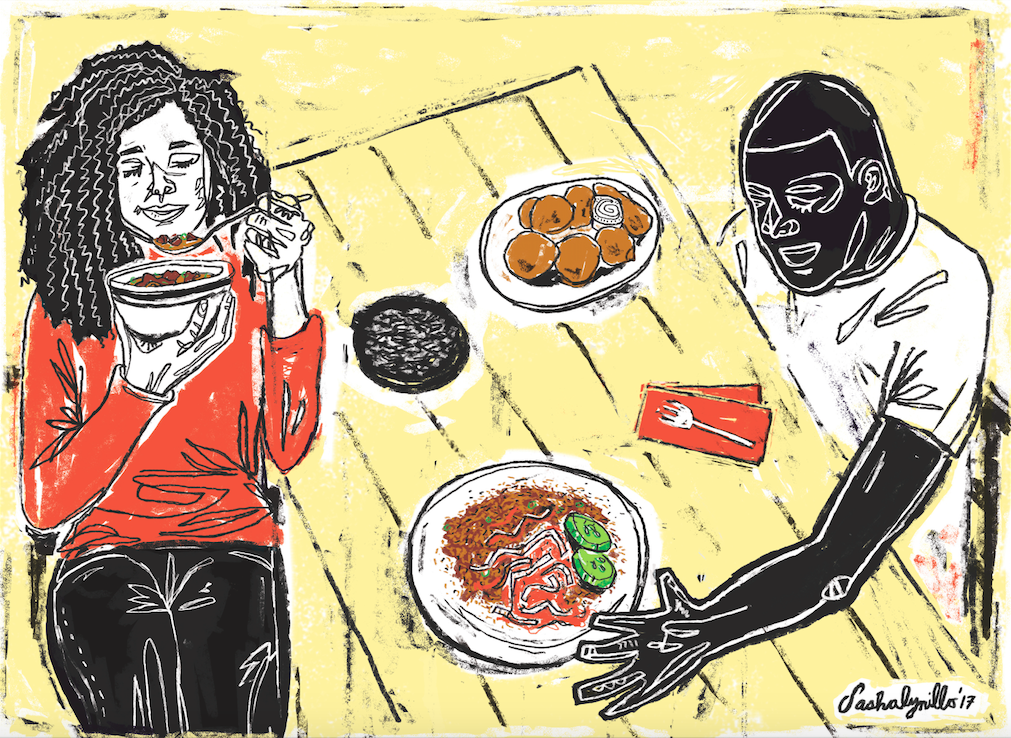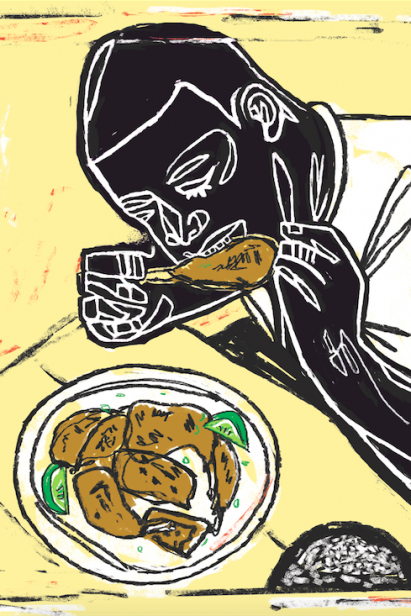Under The 6
The neighborhoods under the 6 train are changing. Driving down my old neighborhood, I’ve noticed a crop of new restaurants popping up. New countries appear on storefront signs, new flags waving in windows: Guyanese, West Indian and Bengali. Admittedly, I had to consult a map to find out Guyana was on the northern coast of South America. What do they eat? What’s inside these restaurants? I had no idea. Spicy curried food, I imagined.
Well, I wasn’t totally wrong, but clearly out of my league in food expertise. So I reached out to my old college friend, Vishall, for some help. He is a first-generation Guyanese American who grew up in the Bronx, and I hoped he would enlighten me on the expansion of Guyanese culture and community in the neighborhood. He recommended we check out the new girl on the block, Melanie. Assuring me this was the “best” example of Guyanese cuisine, he became my guide in a neighborhood I thought I knew so well.
Melanie’s Roti is across from the Carvel I frequented with my family whenever I missed the Mr. Softee ice cream truck. (My little legs could only run so fast!) That locale on Newbold and Castle Hill Avenue wasn’t Melanie’s back then; I don’t remember what it was. But once you step inside you would guess that it has been in the center of the neighborhood for a long time. Suneta Naraine, the co-owner and manager, stands at her post behind the bar made by her husband, chef and co-owner, Munesh. Drinking buddies file in and fill the stools while families make themselves at home at the tables. Suneta greets them all by first name.
The Naraines are not restaurateurs by trade. Suneta was a paralegal for 20 years and Munesh worked delivery out in New Jersey until the recession of 2008. He was the family cook before he became a chef. “I cooked out of necessity growing up,” he says, “but I had a passion for it, too.”
After Munesh lost his job, Melanie’s became both a passion project and source of income for the family. An ambitious career woman, Suneta believed in her husband’s talent and passion for food. They opened their doors while creeping out of the national financial crisis in March 2009. “I just want to see him happy,” says Suneta. “He is my rock.” I bet he would agree that she is his biggest advocate.
The story’s soundtrack could very well be the Bollywood show tunes that fade into the background of happy customers laughing over a bucket of ice-cold brews. You would think you were walking into a local Indian dive. But don’t be misled by the music. As much as this love story is about sacrifice and family, it is also a love story between cultures and cuisines.
Guyanese food is what foodies would call “fusion”: Indian, West Indian and Chinese cuisines melt into savory Asian sensations with tropical touches.
Suneta came out with several dishes to represent the cross-section of cultures. First, her husband’s jerk chicken, adopted from West Indian cuisine. “It’s what we’re known for here,” says Suneta. The classic spice kick was accompanied by flavor a bit mellower, but just as ticklish on the tongue—a result of deep marinades and a perfect jerk-seasoned crust.
Second, the Chinese fried rice. Brought over by Chinese immigrants that populate much of the Caribbean and Guyana, a deeper color and flavor is imparted by New World spices. “I’ve never had Chinese fried rice,” says Suneta, referring to the takeout classic. “But I promise you, this is better.” An assortment of colorful peppers definitely makes this dish stand out from its Chinese American cousin.
Next, the distinctly Guyanese thin, golden-crusted fried chicken. The crust melts into the juicy chicken, and continues to melt in your mouth. It dresses the fried rice in its flavorful juices when paired together. “You gotta have your heart and soul in this,” Suneta informs me. That’s exactly what it is: soul food.
I was suddenly transported to a place between Asia and the New World and I don’t even now how I got there. “I’m like you,” says Suneta: “When I eat here I get a sense of ‘wow.’”
Speechless and slightly overwhelmed, I turned to Vishall with tears in my eyes. Tears? The food wasn’t that spicy, but I’ve always been an emotional eater. I tasted something unique, both familiar and surprising. Love, perhaps, but that would be too cliché. Suneta assures me, “Yes. It’s love.”
Culture and family are the center of Melanie’s. Suneta’s daughter and restaurant namesake, Melanie, calls her mother to say she’s on her way from school. In the middle of us sampling some Indian-inspired chicken curry and roti, Suneta’s middle child, Tushar, walks in. The not-too-spicy curry melts into the flaky roti wrap.
“I try to teach my kids who they are, where they come from,” says Suneta. She seems to have done well. Her eldest, Timal, walks in. The gang is all here and I realize that they are Melanie’s.
This is a second home for many. “The customers become family. It reminds me of ‘Cheers,’” says Suneta. “A neighborhood bar where everyone knows each other.” Everyone did know each other’s name. It’s been that kind of neighborhood for as long as I can remember: friendly and familiar.
Some family friends of Vishall arrive, regulars at Melanie’s. It’s like a family reunion. Suneta greets and hugs them, Vishall gets up and they inform him they’re celebrating a birthday with a few beers. Food, drink and family: It carries an identity across the globe and transforms a corner of the Bronx into a corner of Guyana.
Guyana, much like the Bronx, is a crossroads for international flavors and cultures. It’s a familiar narrative, global and influenced by generations of migrant history. Even if you can’t find Guyana on the map you can understand the experience at Melanie’s. It’s more than good eating; it’s a love story.
Visit Melanie's Roti Shop,1248 Castle Hill Ave, Bronx, NY 10462








